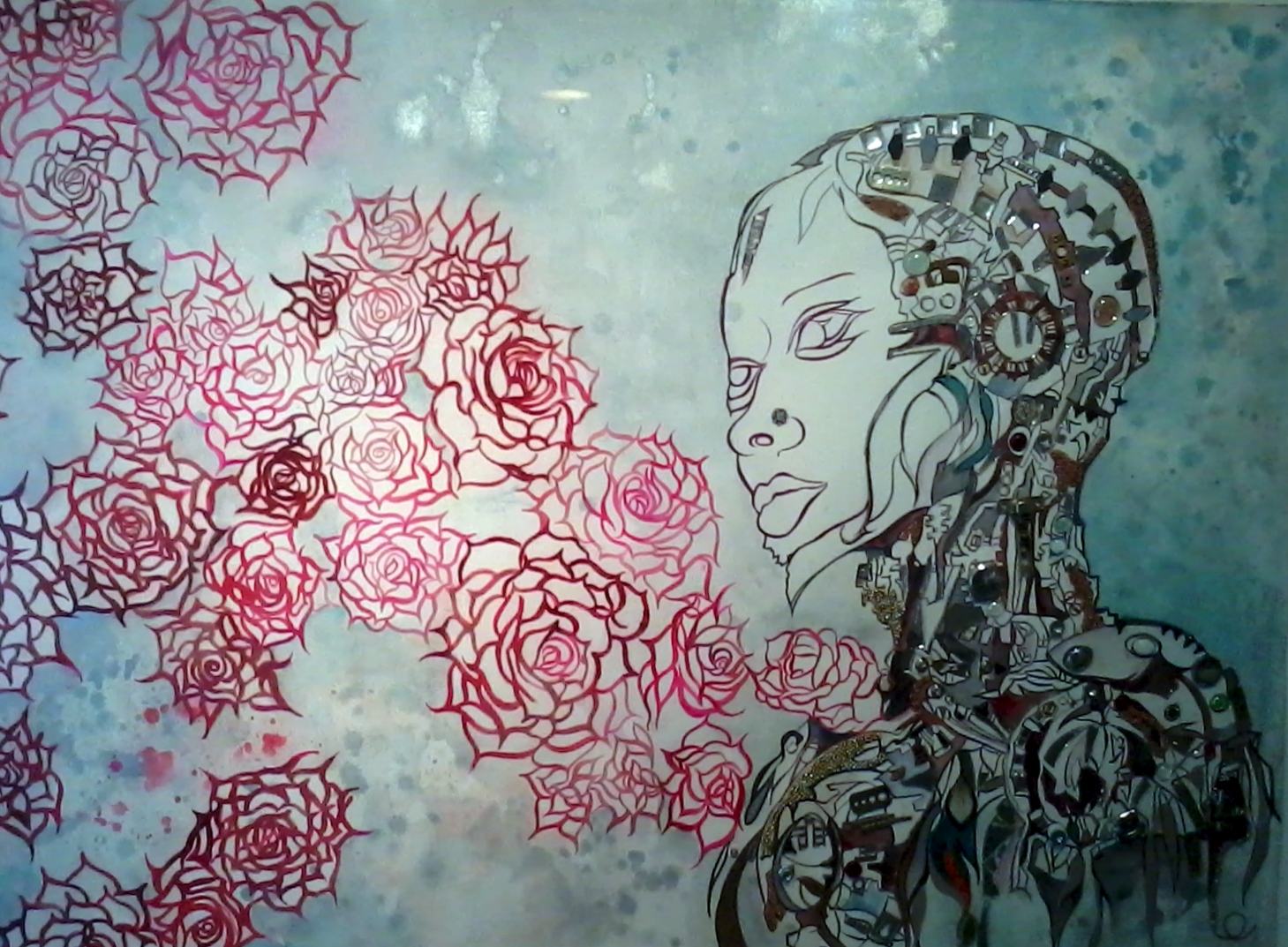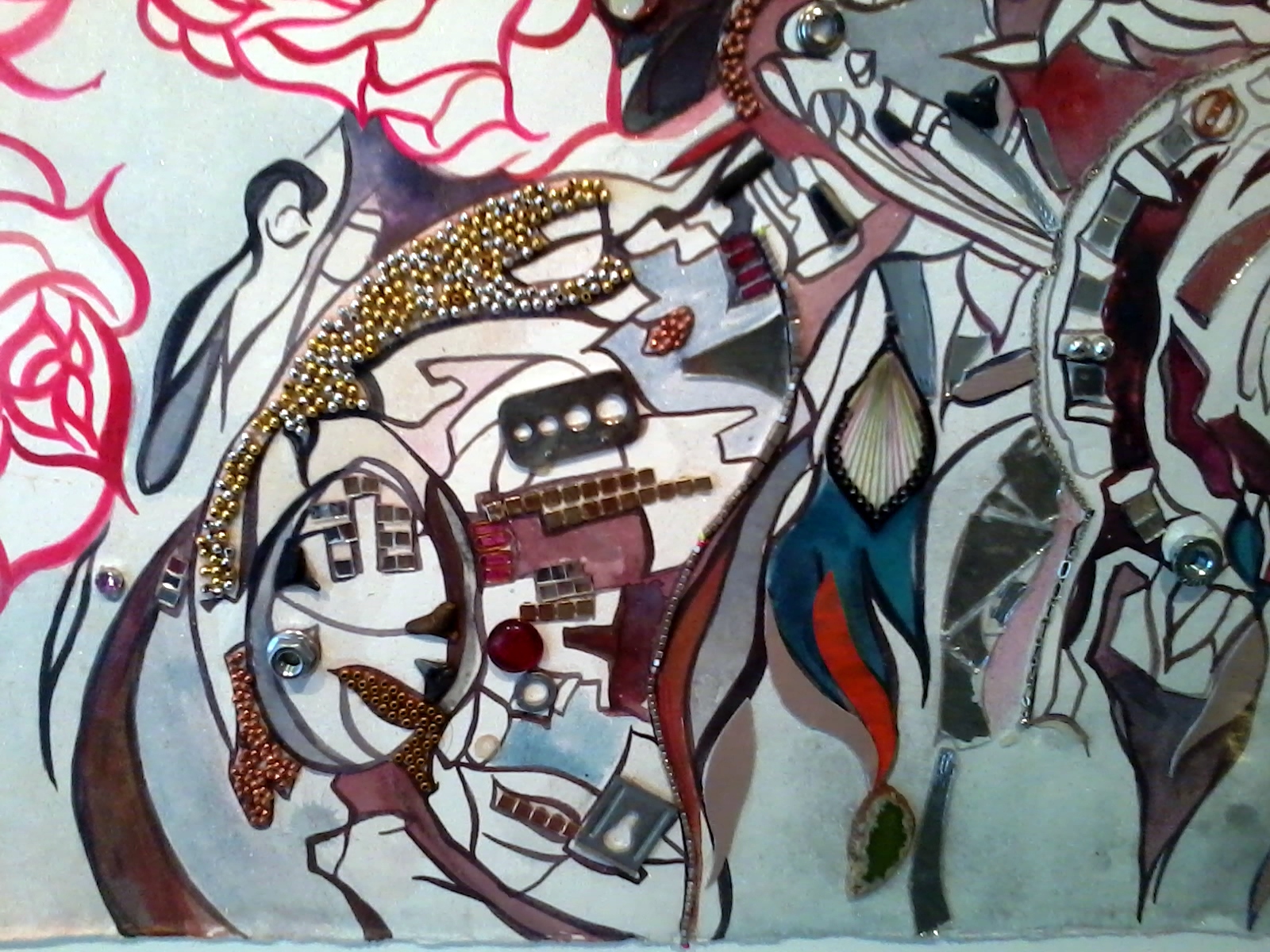Mirror shards, watches, mechanical junk, hardware parts, golden beads, glitter construct a woman’s bust on paper, while from her bosom emerge a series of ethereal red roses-their lightness well contrasted with the heaviness of the robotic women. The nose accessory, forehead bindi and the facial features bespeak a South Asian face. These women are often part goddess-part cyborg; deified as superwomen and demonised as monsters. They are three headed, three eyed and three breasted, the mouth carrying a ferocious projecting dentition. There is a perverse delight in nudity; breasts are frontally represented with nipples as plastic affixations to resemble Turkish evil eyes while vaginas occasionally sprout into roses. This act of perversity and voyeurism is self referenced by the abundance of the eye motif in works like Splash.
**
Brooklyn based artist Chitra Ganesh’s first solo show in the city titled A Zebra Among Horses opened recently at Gallery Espace, New Delhi to include drawings on paper; a collage on board, a site-specific mural-based installation; and a text-based wall piece. In the solo exhibition, Chitra Ganesh re-engages with and extends further her ideas on femininity, gender politics and sexuality by bringing about an intriguing intersection of myth and sci-fi, the visual and the haptic, the text and the image. Using the language of collage, automated drawings, doodles and mural installation, Ganesh gives a powerful thrust to the stream of subconscious thought. Her work reflects a rich symbolist register where free association, memories and aspirations are propounded in an alternate narrative space while her use of everyday found objects gives a sculptural quality to her drawing making them three dimensional rather than flat.
In her paper collage installation “Inner Eye,” which was done in part at the studio and in part at site, drawings are sewn, pinned or layered on top of each other to form an organic body of work that shows the artist’s process rather than a singular end product. While some of the drawings are recent others date back to several years, some are doodles, others woodcut prints and many have an unfinished quality. Conventional and unconventional objects of decoration like paper flowers, Easter grass, feathers, fishnet stocking, butterfly, marble, beads, glitter etc is juxtaposed with grotesque imagery and horrific mutation accompanied by text like “Memoirs Of A Bleeding Tongue” and “A Spoonful Of Head.”Chitra Ganesh explains, “The decorative and the grotesque are often seen as dichotomous but I am interested in how they meet. In my works I wish to explore the construction of femininity as a tension between the grotesque and the decorative.”
**
The site specific mural was created in situ over a period of five days using an overhead projector to project images and tracing them over the wall with the help of an assistant. Using three dimensional objects like fishnet stocking, paper cut outs, rose bud eyes; Ganesh has drawn a young girl holding a gas mask with a noose like structure emerging from her head to encircle another woman who meets her gaze. The loop of morbidity is extended further with a nude sitting with her fingers crossed looking at the noosed woman awaiting or resisting a similar fate. On the other side, two hands emerge from a rain burst cloud one caressing the drop while the other keeps its fingers crossed. This surrealist narrative expounds Ganesh “combines the dystopic and the toxic with themes that traditionally signify beauty.”
**
Appropriating the Greek mythological tale where Atlas was punished by having to hold the world above his head, Ganesh transposes the Greek hero for an ordinary woman burdened by the universe of memories and experience her body tattooed or marked to represent an alternate culture or space. The politics of subverting heteronormative and hegemonic narration by giving voice to the marginal or peripheral character or alternative sexuality has been a repeated engagement in Ganesh’s work. Although the artist appropriates a wide circuit of references in her works namely Hindu, Greek and Buddhist mythology, calendar art, graffiti, fairytales, contemporary visual culture such as Bollywood posters, animated films, and comic books for her re-appropriation of the Amarchitrakatha series wherein she uses the visual aesthetics and framing of the comic while inserting her own visual vocabulary and text into it.
**
Discussing her technique of creating these archival light jet prints the artist shares “They are created using imagery I drew combined with imagery I appropriated and imagery that I drew directly into the computer templates inspired from B grade comic from the 70’s and the 80’s sci-fiction and Indian comic series Amarchitrakatha.” Set in an inter galactic landscape, the myth intersects with sci-fi and the popular mythology takes a further twist with women as lead protagonists instead of being obliterated or seen simply as a cause of epic battles or tragedies as they traditionally were. It is these gaps in narration that inspire Chitra Ganesh to recover the lost feminine narrative in cultural history.
For Chitra Ganesh, it is the accessibility of the comic form that provides an easy entry to the audience since “the way in which the comic pairs the text and image is something people feel equipped to decipher because it is a visual form that they have been looking at since they were Using a familiar medium that the audience is comfortable with, Ganesh is however quick to shock them by a seemingly unreal, subversive narrative where disjointed imagery is wedded to loose-dreamlike text that omits any attempt at linear progression making it “poetic and rather than illustrative.”
**
Chitra Ganesh’s oeuvre is marked by a persistent preoccupation with two central themes-the body and the myth. For Ganesh, the body is a site of violence as well as pleasure, power as well as desire. Bodies are marked internally or externally and become a carrier of personal memory which is often enmeshed within the corpus of the collective memory or archetypal burden.
**
“For the artist “the interior and exterior of the body are not necessarily separated and the body is not contained” and the use of three dimensional objects as a way of extending the body creates a spillage onto its environment. They are “Deleuzian bodies without organs”-a body without any organisational principles. The body is fragmented and mutilated, grossly dismembered and morphed -hands emerge from the stomach, legs come out from where the hands should have and the head is obliterated to let a set of canine grow from the neck. There is a scatological fixation with the bodies often shown excreting or farting. However, this gory, grotesque representation of the body is also occasionally met with perverse fetishization. These fragmented bodies belie cultural and geographical trapping as brown/Indian/South Asian belonging instead to a “porous, sub-individuated fragments of matter, viruses and parasites.”
**
Ganesh is a contemporary myth maker who appropriates imagery from Greek, Hindu and Buddhist mythology as a form of social critique. Her work then becomes a visual investigation to ascertain the role of mythology and folktales in shaping the identity of a diasporic community/artist where the mythical past is actively being revisited, questioned and re-narrated to salvage the marginal narrative from the periphery of neglect. Through mythological interventions, Ganesh brings about a violent collision between control and transgression, death and liberation, grotesque and decorative, wilderness and domestication, nostalgia and alienation, futurism and pastness in her imagery. It is an unsettling world where binaries intersect and remain in dialogue with each other.”
All photographs were taken by Habiba Insaf at Gallery Espace unless mentioned otherwise.
Habiba Insaf is a postgraduate student of Arts and Aesthetics at Jawaharlal Nehru University, New Delhi. Her writings have been previously published in Art and Deal, Open Democracy and Emaho Magazine. She has interned with Mehrangarh Museum, Jodhpur, India Art Fair, New Delhi and Volte Gallery, Mumbai. She is a freelance researcher for an online start-up for modern and contemporary South Asian Art and also writes for a New Delhi based artist.








